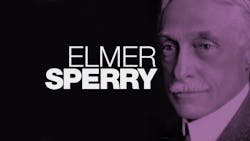Elmer A. Sperry: One Part Inventor, One Part Entrepreneur
Brains and business sense. This extraordinary combination helped Elmer A. Sperry found eight companies and earn close to 400 patents. His designs spanned many decades and industries, starting with dynamos and arc lamps for outdoor lighting and progressing through mining equipment, streetcars, batteries, and railroad safety devices.
Chief among them, the gyroscopic compass, made piloting ships, airplanes, and spacecraft more reliable. This invention earned Sperry the distinctive title of "father of modern navigation technology."
Born in New York in 1860, this curiosity and talent for inventing revealed itself at an early age. At the age of six, he concocted a horseradish grater for his aunt. As a boy, he loved to ride on delivery trucks as they transported machinery, peering into the crates to catch a glimpse of the fascinating machines inside. Yet Sperry always maintained that it was the technological exhibits he saw at the 1876 Philadelphia Exposition that determined his future career path.
Sperry never completed his formal education. After a year of studying electrical engineering at Cornell University, he left to begin his prolific career. But his short time at school yielded his first design. His dynamo and its highly efficient armature dramatically increased current production and powered arc lamps to light the Cornell University campus.
By the time he reached the age of 20, Sperry parlayed his invention into his first business venture, the Sperry Electric Company, which manufactured dynamos and arc lamps. He also developed an automatic, electromagnetic regulator based on closed-loop feedback control that could, in the event of an overload, extinguish all lamps in an arc lighting system without damaging them.
Subsequent companies would include the Sperry Electric Mining Machine company, which manufactured mining equipment, and the Chicago Fuse Wire Company, which created electric fuse wire using machines he had invented. A number of Sperry's patents were products of his experimental work with electric streetcars. Like his earlier work with arc lighting systems, these patents reflected Sperry's interest in automatic control systems. He thought that these systems would solve many of the streetcars' power-transmission and braking problems.
During the late 19th century, Sperry was considered one of America's electrical pioneers. However, his most successful and significant business venture was the one he built around the gyroscope.
In 1890, G.M. Hopkins invented the first electrically driven gyroscope. The gyroscope basically consists of a base-mounted disk that can spin freely on its X and Y axes and maintain its orientation regardless of any movement of the base. A properly mounted gyroscope will always turn to match its plane of rotation with that of the Earth.
Sperry realized that adding electricity to the gyroscope transformed it from a scientific curiosity to a reliable reference device. Thus, it could ultimately replace the unreliable magnetic compasses used in steel ships.
Inspired by its vast potential, Sperry began work on his idea in 1896. He combined electrical and mechanical elements into gyroscopic compasses and stabilizers for ships and airplanes. He patented his gyrocompass in 1908 and founded the Sperry Gyroscope Company in Brooklyn, N.Y., two years later.
Defense R&D
Sperry worked closely with the U.S. Navy to test and perfect his inventions. In fact, he helped launch a new era in research and development, characterized by increasing government influence on the direction of technology for military purposes.
His gyrocompass was first installed on the U.S. battleship Delaware in 1911, and it played a pivotal role for the Navy during World War I. During the war, another famous Sperry product was developed—a gyroscope-guided ship autopilot that became known as "Metal Mike," the mechanical helmsman.
Within a decade of the original gyrocompass patent, Sperry developed the ship gyrostabilizer, marine gyropilot, high-intensity searchlight, firecontrol system, and aerial torpedo, as well as the gyroscopic turn indicator that allowed flying without visual reference to the ground or horizon.
All of these gyroscopic inventions used the principles of automatic guidance and feedback control, and they relied on analog computers, servomotors, and programmed controllers. In recognition of Sperry's technological contributions, the U.S. Navy launched the USS Sperry on December 17, 1941, and she served with distinction until 1982.
Big business
After World War I, Sperry began expanding his Gyroscope Company into the European and Japanese markets. It obtained Mitsubishi as a Sperry products licensee. Elmer Sperry gave up the day-to-day operation of his company in the 1920s, instead turning his attention to experimenting with diesel engines until his death in 1930.
After World War II, Sperry's company extended into the growing field of electronics. Acquisition of Remington Rand in 1955 produced the Sperry Rand Corp., and a subsequent merger with Burroughs in 1986 formed technology giant Unisys Corp. During the 1980s, the original gyroscope business was sold off and evolved into Sperry Marine. The company still manufactures and sells the gyrocompass, almost 100 years after its invention.
Elmer Sperry was first and foremost an engineer and inventor of the highest caliber, whose innovation cemented his place in high-tech history. On the other hand, he was equally talented as an entrepreneur. While his interests and achievements were many and varied, he'll always be best known for helping safely guide us through the sea, air, and space.
